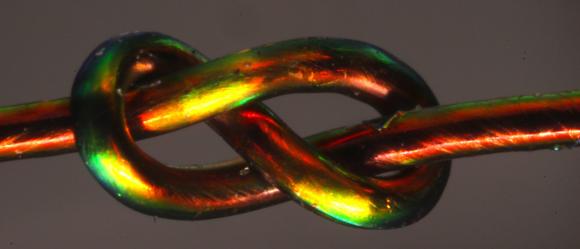 An interesting new technology, involving special fibers that change color when they are under strain, is allowing scientists to analyze the efficiency of knots. The technology is described in a recent paper by a team lead Vishal P. Patil in the journal Science.
An interesting new technology, involving special fibers that change color when they are under strain, is allowing scientists to analyze the efficiency of knots. The technology is described in a recent paper by a team lead Vishal P. Patil in the journal Science.
On observation from the study is, as Patil explained to NPR, is that “twist is quite important in how knots behave.” Having lots of twists going in opposite directions along the knot can kind of lock it. “But if lots of twists are going in the same direction, then the whole thing can roll out.”
Other important factors include the amount of friction in the knot and its overall complexity.
As insightful as the new work may be, it is also clear that scientists and sailors occupy different realms.
“It seems like humans just lucked out and discovered some good knots,” says Patil, “but it’s kind of unclear how.”
He notes that inventing knots seems to be a uniquely human activity and that such complicated knots don’t appear in nature.
“The question of how did people even come up with these knots kind of baffles me,” says Patil. “I guess if you spend a long time at sea, maybe eventually you work out a good way of tying something to something else.”
Marlinspike seamanship is both an art and a science. Over a few thousand years of seafaring, it seems perfectly reasonable that sailors might determine which knots work for specific applications and which do not. Sailors did not need computers or special fibers to develop these knots. Why that should baffle anyone remains unclear, at least to me.
Strain On A Figure-Eight Knot
A figure-eight knot made using a color-changing fiber shows patches of yellow, green and blue to indicate regions of high strain. This particular fiber has been immersed in an oil bath to reduce the influence of fiber drag.

“Why that should baffle anyone remains unclear, at least to me.” I could not agree more.
A figure of eight is a stopper knot, in the video it can only be part of a tangle when pulled from both ends.
The knot shown I use to tie fish hooks, been doing it for years.
Developed by MIT 5/29/2018 According to Endgaget.
Science Mag as the article on “color changing fabric”. Google says Target has it, but don’t count on it.
Science Mag: science.sciencemag.org/content/367/6473/71
Pingback: Tuesday assorted links - Marginal REVOLUTION
Tying the knot April 4th 2020. Wedding planning needs a hack.
Pingback: Why Knots Work and Why Some Don’t - Moldy Chum
“The question of how did people even come up with these knots kind of baffles me,” says Patil.
It would baffle me if people DIDN’T come up with these knots. No matter what they think, engineers don’t have a corner on ingenuity.
Put two ropes in an empty box and shut it.
When you open it again a few days, weeks, months later the ropes will be completely entangled and in that mess will be at least one useful knot.
I am sure it is a fundamental law. It must have a name.